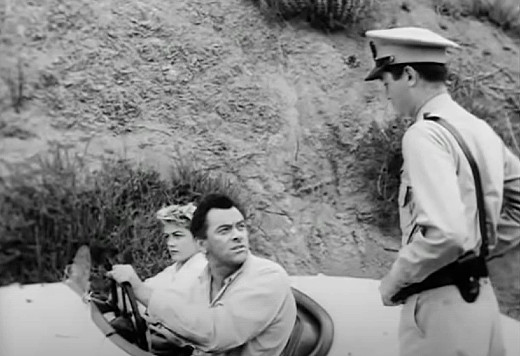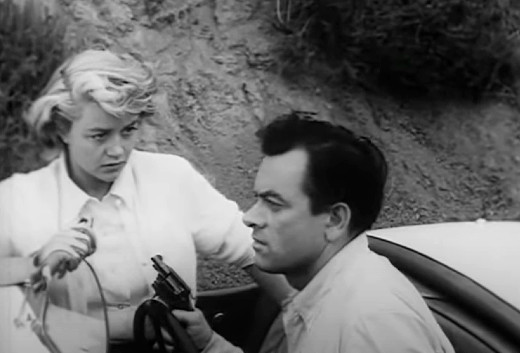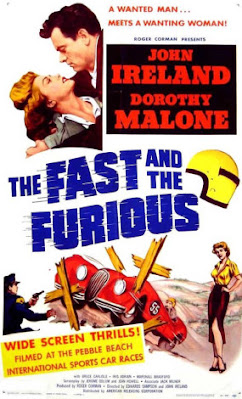Pros: Classic hard-boiled dialog; Dorothy Malone as a kidnapped socialite with Stockholm Syndrome is very good.
Cons: The racing action is mostly limited to the last 10 minutes of the movie.
This post is part of the Corman-verse Blogathon hosted by Barry at Cinematic Cartharsis and Gill at Realweegiemidget Reviews. After you finish up your visit here, head on over to their blogs to further explore the multiverse of producer/director/writer/actor Roger Corman.
I believe I’ve mentioned that I’m old at least a couple of times on this blog (as if the films that I write about weren’t a big tip-off). To give you an idea of how old, I grew up watching TVs with vacuum tubes and rabbit ear antennas, used rotary dial phones to make calls over party lines, and filled up cars that were almost as heavy as army tanks with leaded gas that cost the princely sum of 40 cents a gallon.
I mention this only to put the enduring career of Roger Corman into some kind of context. I am as old as dirt, yet here is a man who produced his first movie before I was even born, and is still working to this very day! I will pause a moment to let that sink in…
Okay, back to business.
The Fast and the Furious was one of Roger Corman’s earliest producing gigs, and was groundbreaking not only for Corman’s career, but for the legendary American International Pictures, which at the time was a fledgling start-up known as American Releasing Corporation. More on that later.
Clocking in at a fast 73 minutes, The Fast and the Furious tells the story of a desperate man, Frank Webster (John Ireland), who has escaped from prison after being convicted of a bum murder rap. The film opens with Frank trying to be inconspicuous while he gets a quick bite to eat at a roadside diner.
A nosy trucker (Bruno VeSota), strikes up a conversation with Webster and ends up offering him a ride. But with news of the escape all over the radio, the trucker quickly becomes suspicious and pulls a gun, hoping to make a citizen’s arrest.
Webster grabs the gun and coldcocks the rotund trucker. With no other way to get out of there fast, he kidnaps attractive socialite Connie Adair (Dorothy Malone), who is in the wrong place at the wrong time, and forces her to ride off with him in her expensive Jaguar sports car.
 |
| This nosy citizen is about to get a knuckle sandwich at the greasy spoon diner. |
In theory, it should be a quick run to the Mexican border in the souped-up Jag, but word of the kidnapping has gotten out, and state troopers have set up numerous roadblocks.
To compound Webster’s headaches, Connie is a smart, capable woman who is constantly thinking of ways to escape or attract the attention of the authorities. He alternately threatens her with the gun or ties her up to prevent her from running off. At one point, he even wraps his arms around her in the open-air car as they spend a cold night on a remote mountain road.
The roadblocks seem insurmountable until Webster notices a number of sports cars passing through the police checkpoints. They’re on their way to an event that Connie is very familiar with -- an international race that starts in Southern California and finishes up across the Mexican border.
Webster slickly maneuvers the Jaguar into the line of cars bound for the event and pretends he’s one of the racers, even getting a police motorcycle escort to the event staging area. At this point Connie is very conflicted about Webster. She’s attracted to him in spite of herself, helping her kidnapper register for the race under an assumed name and fending off her wealthy friends who are overly curious about the new man in her life.
 |
| Producer Roger Corman doubles as a clueless state trooper. |
During some downtime before the race, Webster tells Connie his tale of woe -- he was an independent trucker who attracted the attention of a mob-run trucking company. When he refused to join up, one of their goons tried to run him off the road, but ended up crashing and killing himself. Another goon testified that Webster was the aggressor, and so he ended up in jail.
Connie completely buys the story, and begs Webster to turn himself in. Understandably leery of the “justice” system, Webster is determined to carry through with his plan to race to the border and freedom, and locks Connie up in a shack near the race staging area so that she won’t be tempted to turn him in.
Anyone expecting even a fraction of the crazy energy and stunt work of the Vin Diesel-led Fast and Furious franchise will be sorely disappointed. The 1954 film was made fast (and cheap) and furiously marketed to drive-in double bills.
There’s a quick pre-titles scene of a truck crashing and burning, there’s the altercation in the diner, and there are shots of sports cars racing over curving mountain roads in the last 10 or so minutes, but by and large the action and suspense boils down to the love-hate relationship between Webster and Connie.
Webster doesn’t do himself any favors, spending a big chunk of the movie manhandling Connie and barking at her. At one point, when they’re stalled at the side of the road, Connie nervously observes that “It’s almost midnight”; Webster counters with a snarky “Do you ride off on a broom?”
 |
| Webster is beginning to regret his decision to kidnap Connie. |
Amazingly, Connie seems to be able to get past the rough exterior (not to mention the death threats) to see the good in Webster. But she swings wildly between hatching escape plans and aiding and abetting his escape. In one scene, she impulsively snatches the key out of the ignition while Webster is driving and throws it into the brush. Then, minutes later, she coquettishly waves a spare key in front of the flummoxed man’s face. You want to reach through the screen, shake her and tell her to make up her mind.
It’s at the shack on the racing grounds, hiding out from the police, that the accidental couple finally declare their love for one another. After spending the night there, Connie thinks that Webster is going to do the right thing and turn himself in, but is shocked when it becomes obvious that he's still going to make a run for it.
It’s a wealthy socialite's innocent trust in the system vs. a working man’s cynicism:
Connie: "You go to Mexico and you’ll give up the only chance you’ve got!"
Webster: "That’s not the way I see it.…"
Connie: "Don’t you want me?"
Webster: "You’re the most beautiful thing I’ve ever known, but I can’t afford to stay."
Connie: "Oh but you’re innocent!"
Webster: "It isn’t what you are that counts… It’s what you get taken for!"
Connie: "Someday what you really are is going to catch up with you. It’s worth fighting for, I just hope it isn’t too late…"
This being a ‘50s drive-in movie, we’re reasonably sure that trust in the system is ultimately going to prevail, but not before a few more dramatic setbacks. After Webster locks Connie in, promising to alert help once he’s safely in Mexico, she yells her lungs out to no avail. Then, in one of the most boneheaded moves ever, she lights some old rags on fire near the wooden door to … send out smoke signals? Burn the door down? It’s not clear, since she’s far more likely to succumb to smoke before any of those things can happen.
 |
| Connie tries one last time to convince Webster to give himself up after spending the night at the Love Shack (apologies to the B52s). |
SPOILER ALERT!
Well, of course she’s rescued in the nick of time so she can fight for her man another day. But please kids, don’t try this at home!
The protagonists’ knuckle-headed moves aside, The Fast and the Furious is a pretty watchable low-budget action-thriller-romance due to the two leads. While John Ireland was never the most expressive of actors, at various points he gets to rattle off classic hard-boiled lines and zingers like a human machine gun.
Dorothy Malone is very sympathetic as the mixed up rich girl, even as the audience is scratching their heads wondering what her character will do next. In the 1940s Malone flirted with stardom working for RKO and Warner Bros., but by the time The Fast and the Furious began shooting, she was not commanding big paychecks. She managed to snag an Oscar for best supporting actress in Douglas Sirk’s lush soap opera Written on the Wind (1956) before transitioning to mostly TV roles. While The Fast and the Furious was a mere road bump in Malone’s career, it was a far more significant milestone for producer Roger Corman and his star John Ireland.
Corman was fresh off the success of his very first film as sole producer, Monster from the Ocean Floor (1954), when he decided to do The Fast and the Furious. For Monster, he received a $60,000 advance against distribution profits on a film that cost him a paltry $10K to make. Not wanting to let the grass grow under his feet, he sunk a significant chunk into his new project. This would become standard operating procedure.
In his memoir, How I Made a Hundred Movies in Hollywood and Never Lost a Dime, Corman relates:
“My career took a dramatic turn and picked up velocity with The Fast and the Furious. First, this was a considerably bigger, more intricate production. Second, I used the film to get a three picture deal with a new independent production and distribution company -- eventually called American International Pictures. That deal marked the beginning of a long, prosperous relationship stretching over fifteen years and thirty-plus films. And third, I made the decision after Fast and Furious to direct films, not only for the greater overall control but for the creative challenge.” [Roger Corman and Jim Jerome, How I Made a Hundred Movies in Hollywood and Never Lost a Dime, Da Capo Press, 1998, p. 23]
Jim Nicholson and Samuel Arkoff were just starting out with American Releasing Corporation, (soon to morph into American International Pictures), and The Fast and the Furious was only the second film to be released under the ARC banner. Roger Corman was just the man to supply the fledgling enterprise with films made furiously fast and cheap. The partnership spawned such legendary quickie classics as The Little Shop of Horrors (1960) and the comparatively lush Poe pictures starting with House of Usher (1960).
With just this second producing job, Corman was already a master of economizing. Ireland, who by that point had dozens of films under his belt, initially turned down the Webster role, but came on board at a cut rate when Corman okayed his request to direct the film.
 |
| John Ireland races to the set of The Fast and the Furious after getting the word that he can direct. |
Much of the racing footage was shot at an actual event, the Jaguar Open Sports Car race in Monterey, CA, obviating the need to rent cars and drivers.
Corman also immersed himself in other aspects of filmmaking, doing second unit directing, appearing uncredited in a small role as a highway cop, and even performing some stunt driving. This latter job brought out the man’s competitive spirit in a humorous way:
“I also went behind the wheel of the lead heavy’s car and raced in the key action sequence. Because I couldn’t afford two stunt drivers, John, who directed the long master shot, put our one driver in his own white Jag. Coming around the final turn neck and neck, knowing the other driver was supposed to surge ahead and win -- I got carried away and beat him, ruining the first take. John ran to the track and said, ‘What the hell are you doing out there?’ I said, ‘He wasn’t going fast enough. I wasn’t exactly going to hit the brakes and let him pass.' … We got it right the second time and the white car overtook me and won. The truth was, I really just wanted to floor it and win. I hated to lose.” [Ibid., pp. 24-5]
Corman kept learning. Compared to his later action-thrillers, The Fast and the Furious is pretty mild and slow-paced. Still, it’s worth watching for the “will they or won’t they?” tug-of-war between Webster and Connie and the hard-as-nails dialog.
 |
| Roger finally lets the white car win. |
Where to find it: The Fast and the Furious is currently streaming down the internet superhighway here and here.


Fun, fact-filled review, Brian! I love reading the stories about how Corman made every penny of his productions count. It's quite an underappreciated talent. Thanks a million for joining the Corman-verse Blogathon!
ReplyDeleteThanks Barry! The great thing about his thriftiness is that without it, we'd have far fewer Roger Corman movies to enjoy. ;) Thanks for co-hosting this!
DeleteThanks for joining the blogathon and love the title!!! I LOVED your description here of "Dorothy Malone as a kidnapped socialite with Stockholm Syndrome is very good." and that fact and the mere 10 mins of car racing scenes totally sold it to me...
ReplyDeleteThanks Gill, I'm proud of that title if I do say so myself. :) I'm always looking for an excuse to write about Roger Corman and his movies, so thanks for co-hosting this great event!
DeleteGreat review! I decided to re-watch this movie tonight and it was as cool as the first time. Here's a good word for Iris Adrian, the queen of the wisecracking dames, and Bruno VeSota, always a welcome presence in a movie. The opening credits mentioned the music of The Chet Baker Jazz Quartet, which played in the diner scene, but was barely audible because of Miss Adrian's non-stop dialogue. But I'm not complaining.
ReplyDeleteThanks Mike! The diner scene is wonderful, with Bruno's sleaziness, Iris' constant chatter, and Connie just wanting her pineapple juice. I did notice the credit for the Chet Baker Quartet, but I confess I didn't notice it playing in the background.
DeleteRabbit ear antennas... the good old days! We put aluminum foil on them. LOL! Anyhow, I liked the film. Ireland and Malone are good, and the story is entertaining.
ReplyDeleteDid that aluminum foil bring in an extra station or two? :) I thought that the idea of hiding in plain sight and using an international sports car race as a means to get to Mexico was pretty inventive. And watching the back and forth between the two protagonists was fun.
ReplyDeleteI've had the DVD sitting on my shelf for a year or more. Now I'll just have to watch it. I'd forgotten Dorothy Malone was in it - she's always entertaining.
ReplyDeleteIt's interesting that although Malone had worked steadily through the '40s and had been in dozens of films before this, she was still accepting roles in low-budget films heading into the mid-'50s. Of course, she was just two years out from hoisting the Oscar for her bad girl role in Written on the Wind. Definitely give it a viewing, the two leads are a lot of fun!
DeleteClever pun on the title there. :D I tend to focus on the horror and sci-fi output of Corman so have yet to watch this one. But you make it sound pretty entertaining, so I think I need to change that. I'm happy to read that Bruno VeSota makes an appearance. He was as much a mainstay of Corman films as Dick Miller.
ReplyDeleteThanks for stopping by! I too have focused on Corman's horror and sci-fi on the blog, so I thought I would mix things up a little bit and go for something very early in his film career that had a big impact -- the beginning of the partnership with AIP and the film where he got the itch to direct. In addition to VeSota, Jonathan Haze has a bit part as the good Samaritan who rescues Connie from the burning shack.
Delete"Love Shack" is in my head now. Oh well. :-) This was a fun review, Brian!
ReplyDeleteIt's been bouncing around in my head intermittently for a couple of weeks now. :) Glad you enjoyed it Rebecca!
Delete